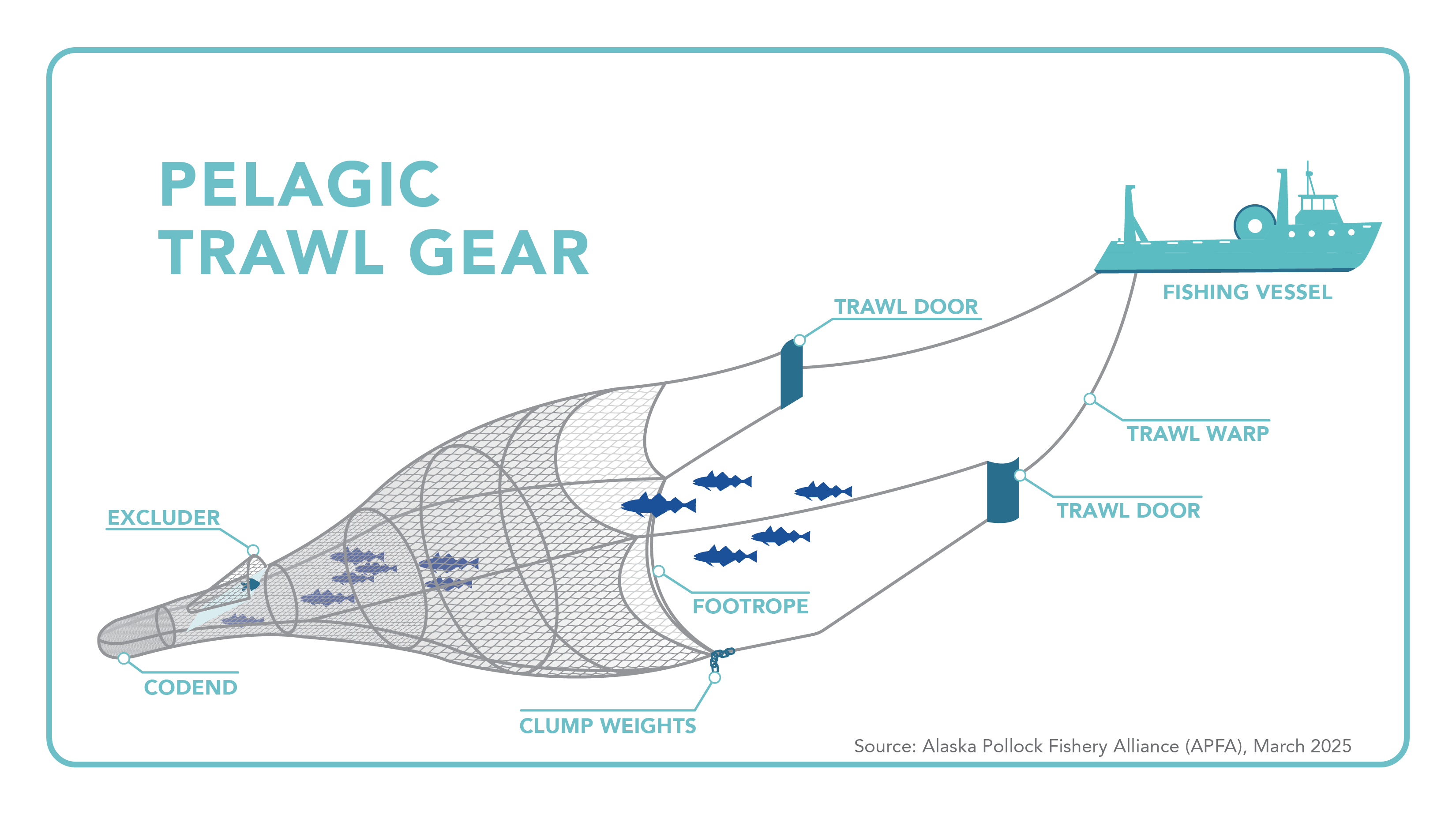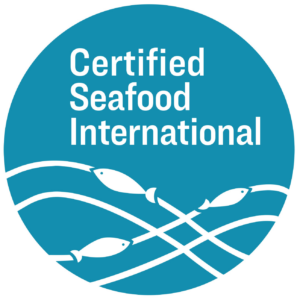Alaska Pollock
The U.S. Alaska pollock (Gadus chalcogrammus) commercial fisheries were awarded continued certification in February 2023. Vessels operating in certified Alaska pollock fisheries primarily employ pelagic trawl gear, although other gear types can also legally land Alaska pollock. Fishing occurs primarily in the federal waters of the United States Exclusive Economic Zone (EEZ) and is jointly managed by the North Pacific Fishery Management Council (NPFMC) and the National Marine Fisheries Service (NMFS). Alaska pollock is a member of the cod family and shares many of the same attributes. It is different from Atlantic pollock, which is a darker, oilier fish. The Bering Sea / Aleutian Islands Alaska pollock fishery is the largest fishery in the United States and second largest fishery in the world.
Certification Reports
Re-Assessment Certification
- AK Pollock Fishery Full Re-Assessment Certification Report – February 2023
- AK Pollock Fishery Re-Assessment Certification Report for Public Comment – December 19, 2022
Surveillance Audits
Surveillance Audits
- AK Pollock Annual Surveillance and Team Announcement – December 2021
- AK Pollock Annual Surveillance Report – May 2021
- AK Pollock Annual Surveillance and Team Announcement – January 2021
- AK Pollock Annual Surveillance Report – May 2020
- AK Pollock Annual Surveillance and Team Announcement – March 2020
- AK Pollock Annual Surveillance Report – Feb 2019
- Alaska Pollock Annual Surveillance and Team Announcement – January 2019
Alaska Pollock Recertified:
The reassessment was conducted using Alaska RFM Standard Version 1.3.
- AK Pollock Full Assessment Final Report, Dec 2017 PDF
- Alaska Pollock Notice of Peer Reviewers September 2017
- Alaska Pollock Re-Assessment Team Announcement May 2017 PDF
- Alaska Pollock Annual Surveillance and Team Announcement May 2017 PDF
Initial Certification:
- Final Full Report:
Download the Final Certification Report - Summary Report: Download the Summary Certification Report
- Comments: Click here to submit a comment regarding the Final Certification Report.
- Confirmation of External Peer Reviewers Pollock, November 2011
- Confirmation of Assessment Team Members Pollock, July 2011
- Announcement of Site Visit Pollock, July 2011
- Pollock Assessment Report Preliminary References Pollock
- Notice of Full Assessment and Verification Stage of Assessment Pollock, July 2011
- Notice of Application for Assessment Pollock, July 2011
- Notice of Full Assessment and Verification Stage of Assessment
Audit 1:
- Annual Surveillance Report Pollock, May 2013 (PDF)
- Comments:
Click here to submit a comment regarding the Final Surveillance Report - Announcement of Surveillance Site Visit, November 2012
- Confirmation of Assessment Team Members, November 2012
Audit 2:
- Annual Audit Report Pollock, February 2014
- Comments:
Click here to submit a comment - Audit Site Visit Plan, December 2013
- Confirmation of Annual Audit Assessment Team Members, December 2013
Audit 3:
- Annual Audit Report Pollock, January 2015
- Form 9b Site Visit 3rd Audit AK Pollock, November 2014
- Notice of 3rd Annual Audit Assessment Team Members, November 2014
Audit 4:
- FAO-RFM-Certification-4th-surveillance-Alaska-Pollock-Final-Jan-29th
- Comments: Click here to submit a comment regarding the Final Audit 4 Report
- Form 9 Assessment Team Nomination, November 2015
- Form 9b Site Visit, November 2015
Audit 5:
- Alaska Pollock Annual Audit #5
- Comments: Click here to submit a comment regarding the Final Audit 5 Report
Fishery Info
Fishing for U.S. Alaska pollock occurs in federal waters of the United States Exclusive Economic Zone (EEZ) off the coast of Alaska, and in Alaska state waters. Harvest occurs in two areas: the Bering Sea / Aleutian Islands, and the Gulf of Alaska.
Alaska pollock is harvested via separate winter and summer seasons in the Gulf of Alaska and the Bering Sea.


Alaska pollock are harvested primarily by using pelagic trawl gear which is characterized by a cone-shaped net and trawl doors that are suspended in the mid-water zone. Pelagic trawls achieve a vertical net opening by attaching clump weights to the lower wingtips of the net, which spread the net downwards and allow it to achieve neutral buoyancy. The bare chain footrope and clump weights may contact the seafloor. Pelagic trawl design is also characterized by large forward meshes that herd fish. This simultaneously allows for more efficient towing through reduced drag and excludes non-target demersal species. Alaska pollock school in large aggregations, enabling them to be harvested with low rates of bycatch.
Management of federal U.S. Alaska pollock fisheries is conducted jointly by the North Pacific Fishery Management Council (NPFMC) and the National Marine Fisheries Service (NMFS). In accordance with the requirements of the U.S. Magnuson-Stevens Fishery Conservation and Management Act (MSA), the NPFMC establishes science-based annual catch limits for federal Alaska pollock fisheries, and NMFS develops and enforces federal regulations. In the Bering Sea, Alaska pollock quota is allocated between fishing cooperatives, including to benefit Western Alaska communities via the Community Development Quota (CDQ) program.
Vessels harvesting pollock that is certified by CSI under the Alaska pollock certificate operate exclusively within federal waters of the United States Exclusive Economic Zone (EEZ) and the state waters of Alaska, as well as home-porting in the U.S. states of Washington and Oregon. U.S. federal and state laws regulate the treatment of workers on vessels that harvest certified Alaska pollock.
Additionally, the catcher-processor and processing fleets that participate in the Bering Sea / Aleutian Islands Alaska pollock fishery have voluntarily certified to the FISH Standard for Crew. FISH is an independent third-party certification program for labour practices on vessels in wild-capture fisheries around the globe. Learn more here.

Known for its versatility, Alaska pollock’s snow-white fillet flakes beautifully and offers a lean texture and mild taste. This tender and mild whitefish is extremely versatile for use in a variety of different recipes that include pan-frying, steaming, poaching, grilling, and baking.
Alaska pollock is packed with lean, high-quality protein and marine-derived omega-3 fatty acids, essential to the human body. Its high protein content is easily digestible and has all nine amino acids the body can’t produce itself — a complete protein of the highest quality.
Alaska Pollock
Serving Size: 3oz (85g) cooked
Source: https://www.alaskaseafood.org/health-nutrition/nutrition-information/#wild-alaska-whitefish

